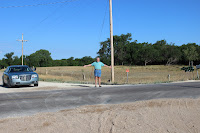Green River is fairly close to the Utah/Colorado border and we headed that way the next morning. Almost immediately after we crossed the border we noticed a change in landscape from the relatively barren, but colorful, sedimentary rock mountains in Utah to the alpine conifer forests that blanket Colorado’s granitic mountains.
 |
| Transitioning to CO mountains |
 |
| Vail ski slopes |
 |
| Ski resort |
 |
| Rocky Mountain high |
 |
| We're on the right road |
 |
| Could this be Pfeifer, KS? |
 |
| St. Fidelis Cathedral |
 |
| The cathedral sanctuary |
 |
| Wolgadeutsche cemetery |
 |
| Volga iron crosses in St.Fidelis cemetery |
 |
| Michael, Larry, and Catherine Pfeifer |
 |
| More beautiful markers |
We left the cemetery amazed at what we had stumbled upon and
headed for Wichita were we had lunch and refueled. It was still early so we
planned to try and make Arkansas before stopping for the night. Our route took
us through Tulsa and then onto Ft. Smith where we checked into a motel. We
decided to find a local restaurant for dinner and went down to the old,
historic section of the city.
Here we found a restaurant called “Sisters.” The
receptionist immediately asked us if we wanted to drink alcohol. We indicated
that we did and were then asked: “Are you a member of the club?” We had no idea
what she was talking about until she explained that it was a “dry” county and
we had to be club members. Thinking that we would have to forgo any drinks or
wine, she then presented a form that when filled out would make us club
members! So that’s how they get around the stupid temperance. One has to wonder
why have the law if there’s always a loophole. We had a nice meal, met the
owner, and left just as a musician (with a banjo!) was getting ready to play.
The owner begged us to stay, but we had had a very long day and elected to head
back to our room.
 |
| Beautiful clouds over Oklahoma |
ADDENDUM: When we got home we checked out Pfeifer, KS with
Google and Google Earth. Turns out the town was not where we thought it was. It
is located about 10 miles south of Victoria and we only went about 6. So close,
but yet so far. It has a post office and zip code 67660. The 2010 census showed
81 people but the current estimate from the town’s database is 68 (it’s easy to
tell who comes and goes!). Here’s a table of demographic data from the 2010
census:
Estimated
Current Population:
|
68
|
Population:
|
81
|
White
Population:
|
79
|
Black
Population:
|
1
|
Hispanic
Population:
|
1
|
Asian
Population:
|
0
|
Hawaiian
Population:
|
0
|
Indian
Population:
|
1
|
Other
Population:
|
0
|
Male
Population:
|
45
|
Female
Population:
|
36
|
Avg
House Value:
|
$91,000.00
|
Avg
Household Income:
|
$32,396.00
|
Avg
Persons Per Household:
|
2.45
|
Median
Age:
|
43.30
|
Median
Age (Male):
|
47.50
|
Median
Age (Female):
|
36.00
|
We thought this was kind of fun. Here’s some links we’ve
found about Pfeifer for the few of you who are interested:
Its magnificent church: http://www.kansastravel.org/holycrosschurch.htm
Info about the settlement of the town: http://www.volgagerman.net/Pfeifer.htm
Info about Pfeifer, Russia: http://cvgs.cu-portland.edu/settlements/mother_colonies/colony_pfeifer.cfm



































